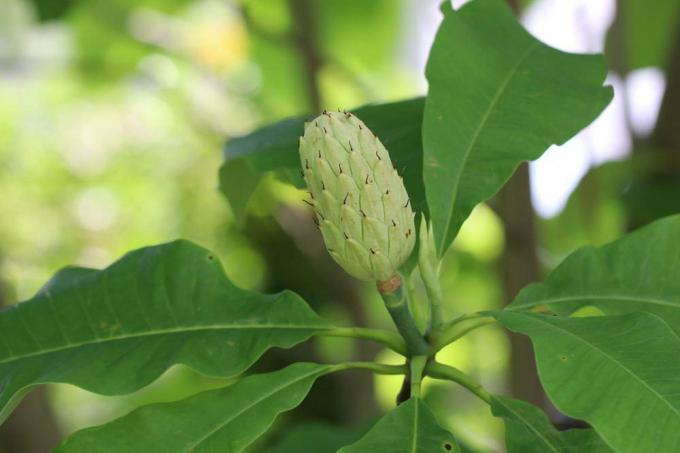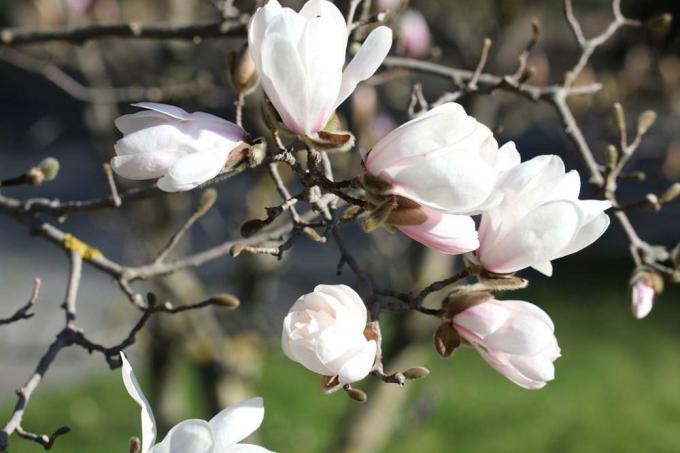
table of contents
- Propagate magnolia
- Propagation by seeds
- sowing
- Germination time
- Propagation by cuttings
- Cut cuttings
- Propagation by subsidence
- Propagation by mossing
Magnolias are among the first heralds of the beginning of spring. They have already found their way into many gardens. Its bizarre growth and the tireless, wonderful bloom enchants every year anew. These imposing plants are available in every well-stocked specialist shop. However, the hobby gardener must expect relatively high prices here. Propagating it yourself is much cheaper if a plant is already available. Here are a few tips on how to do this.
Propagate magnolia
options
There are four different ways of propagating magnolias. With a little sensitivity, it is usually not very difficult to multiply. All that is required is a lot of patience and a bit of luck. Regardless of which method is used, it can take many months before the first delicate roots appear. These decorative ornamental trees can go through
- Seeds
- Cuttings
- Lowerers and
- Mossing
be increased.
Propagation by seeds
Magnolias belong to the cold or frost germs. In other words, the seed must be stratified, i.e. exposed to the cold, before sowing. Obtaining the seed is usually quite simple. After flowering, elongated pods, so-called follicles, develop. These contain the seed. When the fruits become dry, they burst open and the seeds can be removed. It is surrounded by a red shell. Then proceed as follows:
- Soak the seeds in lukewarm water for a few days and rub off the red pulp
- then put the dark seeds in a sealable box with damp sand
- The seeds must be completely surrounded by sand
- Close the can airtight
- Place in the freezer for three to four months before sowing
- in cold winters storage in the garden is also possible

tip: In addition to seeds from the faded flowers, you can also buy seeds from magnolia in good specialist shops.
sowing
After the seed has been treated, sowing can begin at the beginning of spring in March to April, when the soil temperature is at least 15 ° C. This will be
- put some loose substrate in a pot
- Put seeds in and lightly cover with one to two centimeters of soil
- Pot buried in the garden
- Covered with a glass plate in the evening at temperatures below 10 ° C
- in case of severe frost, move the pot to a frost-free, cool place
- Soil kept well moist, but avoid waterlogging
A particularly suitable substrate here
- Humus-peat-sand mixture or
- Potting soil mixed with sand.
Germination time
The germination time of the individual seeds is quite different. It can sometimes last for many months, up to the spring after next. After germination, the young plants should be pricked out after about four to six weeks. Is recommended
- a separation into small pots
- a substrate made from potting soil mixed with coarse-grained expanded clay, gravel or sand
The seedlings are very sensitive to frost. They should therefore remain in the pot for another winter and be brought into the house when it is frosty. Planting them in place in the garden should only be done after about a year, when they are strong enough.

tip: Magnolias propagated from seeds are very often quite lazy to flower. Sometimes the first flowers only appear after a decade. Propagation by cuttings or sinkers and mosses are therefore more suitable.
Propagation by cuttings
Magnolias can also be propagated from cuttings. However, with this method of propagation it is always important what kind of magnolias it is. The cutting time and also the type of shoots to be cut then essentially depend on this.
Deciduous species
- Cuttings in early summer from shoots with still green wood
- alternatively also possible in late summer, then cut half lignified cuttings
Evergreen species
- Cut half-lignified cuttings in late summer and early autumn between late August and mid-September
Cut cuttings
Cutting cuttings is not particularly difficult. It is important to always use clean and sharp cutting tools. It is best to proceed as follows:
- Use garden or rose shears to cut cuttings 20 cm in length
- remove lower leaves and flowers
- Cut the end to be rooted with a sharp, clean knife two centimeters crosswise (promotes root formation)
- dip in rooting hormone
- Fill the pot with a humus-rich soil-sand mixture
- Alternatively, potting soil mixed with sand is also possible
- Insert the cuttings halfway into the moist substrate
- Press the earth lightly
- Keep the substrate evenly moist, but not too wet
- Avoid waterlogging
- Place the pot in a frost-free, light place at 18 - 20 ° C
- If necessary, place translucent foil or bag with holes over the pot

tip: Timber cuttings take root quite slowly and also very heavily. It can take several weeks for the first roots to show up.
As soon as the cutting is rooted, it can be transplanted into the garden in the coming spring. But then there must be no more frost and the ground should be a bit warm. However, it is advisable to leave the cutting in the pot a little longer so that it has a little more time to develop vigorously.
Propagation by subsidence
This method is particularly suitable when there are shoots close to the ground. The best time for this reproduction is from late summer to early autumn, from late August to mid-September. It will
- a long, young side shoot cut three centimeters deep and leaves removed
- a small stone placed in the wound (prevention of wound closure)
- Shoot then pressed into a 15 to 20 cm deep furrow and fastened with hoes
- Then garden soil mixed with compost is piled up, the tip of the shoot must protrude 15 cm from the ground
- Lowerers poured regularly
tip: The mother plant should be fertilized regularly during this time. Ripe compost or rhododendron fertilizer can be used here.
Now patience is required. After two years at the latest, enough roots will have formed and the sinker is strong enough. The new young plant can then be carefully separated from the mother plant and transplanted to its new destination.
This method of propagation is very safe and therefore extremely promising.
Propagation by mossing
The moss removal method is particularly suitable for plants, for example also for magnolias, which are difficult to propagate with cuttings. The mossing is very time-consuming, but it promises good results. Biennial shoots that are the thickness of a pencil and have not yet branched are used here in spring for propagation. A few steps are necessary for this:
- 30 to 40 cm below the tip of the shoots, cut diagonally 2 cm wide around the bark with a sharp knife
- Carefully loosen and remove the bark with your fingers
- Do not injure underlying tissue
- Cut open the plastic flower pot at the sides and bottom halfway (use as a sleeve)
- Wrap the interface thickly with damp moss and press firmly
- Put the flower pot over it and wrap it tightly with transparent foil
- close with wire
- After rooting, cut off the shoot from the mother plant below the roots
- Transplant young plant to destination
- water well regularly
If the moss is kept really moist, the first roots can show up after two to three months. As a rule, however, the moss should remain on the shoot for at least one vegetation period.
tip: The use of moss has the advantage that it has a germicidal effect.


